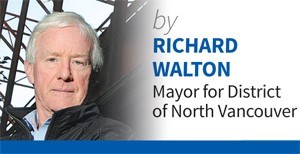As many of you will remember, Mother Nature reminded us of her immense power when she sent huge chunks of rock sliding into the Seymour River back in December 2014.
The rock slide not only flooded the neighbouring forest and trails, but also caused river levels to rise upstream of the slide, submerging Twin Bridge, an important connection for folks wanting to access the vast network of trails in the Lower Seymour Conservation Reserve, west of the Seymour River.
In the interest of public safety, Metro Vancouver had to close a portion of Fisherman’s Trail and remove the old bridge. After consulting with the community, Metro recently unveiled a design concept for a new pedestrian, cyclist and horse-friendly bridge just downstream from the old Twin Bridge crossing, to be installed by year’s end.
They also plan to build a combined vehicle and pedestrian bridge at the north end of Riverside Drive, which will cross over Canyon Creek and connect to Fisherman’s Trail. This news is most welcome by the many district residents (including myself) who use the trails to hike, run, walk their dogs and mountain bike.
But trail users aren’t the only ones who were impacted by the Seymour River rock slide. The waterway is home to wild coho, winter and summer steelhead, as well as pink, chum and chinook salmon.
One of the consequences of the rock slide was that the fish were unable to navigate their way past the rock and debris that has since settled in the river bed. For the steelhead in particular, currently listed as a species of conservation concern, maintaining access to that spawning ground is paramount.
Thanks to a co-ordinated effort between the Seymour Salmonid Society, the Department of Fisheries and Oceans Canada, Metro Vancouver, the Tsleil-Waututh and Squamish Nations, and the District of North Vancouver, we have a plan to create a passage that will ensure the fish can get back to their natural spawning grounds. This process will allow the river to once again become a thriving salmon channel.
A group of dedicated volunteers with the Seymour Salmonid Society are performing the crucial function of rescuing the trapped fish.
In August 2016 they installed a fish fence in the lower portion of the river that helped capture the fish, which were then transported upstream, beyond the rockslide, to their natural spawning ground.
The society’s tireless efforts will ensure that these critical species continue to thrive until a natural passage is established for them.
For more info visit seymoursalmon.com or metrovancouver.org.



